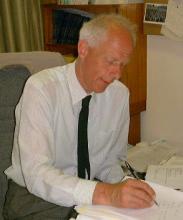|
Professor John Ockendon, F.R.S Emeritus Fellow of St Catherine's College
Tel: 01865-2-70513
|

|
|
Professor John Ockendon, F.R.S Emeritus Fellow of St Catherine's College
Tel: 01865-2-70513
|

|
My abiding interests and commitments concern the application of innovative mathematical ideas to real-world problems, and especially the use of these ideas to unify and simplify complicated and disparate physical situations.
My background was centred on fluid mechanics [1,2], starting with hypersonic aerodynamics, creeping flow, sloshing and channel flows and leading to flows in porous media, ship hydrodynamics and models for flow separation. An increasing involvement with industrial research quickly led me into the burgeoning area of free and moving boundary problems. Diffusion-controlled moving boundary problems scarcely existed as a mathematical research area in 1970, but since then Oxford has been a pioneering centre for its development [3]. My own involvement has centred on models for phase changes and elastic contact problems all built around the paradigm Hele-Shaw free boundary problem. Other industrial collaboration has led to new ideas for lens design, fibre manufacture, extensional and surface-tension-driven flows and glass manufacture, fluidised-bed models, semiconductor device modelling and a range of other problems in mechanics and heat and mass transfer, especially scattering and ray theory, nonlinear wave propagation, nonlinear oscillations, nonlinear diffusion and impact in solids and liquids.
In the physical sciences, I have maintained a strong interest in materials science, especially elastoplasticity, dislocation modelling, sound waves in solids, dendritic growth and superconductivity; and in earth sciences, I have interests in gravimetry, core modelling, dune migration, and vulcanism.
All my work continues to be centred on the application of techniques such as complex variable theory, asymptotic analysis and, above all, theories for solving partial differential equations in new, but well-found models in the real world [4].
My efforts to promote this research led me to organise the annual meeting of the Study Groups with Industry from 1972 to 1989. These meetings are now held regularly in many countries as well as the UK. They quickly convinced me that collaboration between committed applied mathematicians was much the most effective way to gain insight concerning complicated real world processes and hence almost all my research work has been joint with students and colleagues. Also, as a Research Director of OCIAM since its inception to 2008, I have tried to foster a completely open minded and interactive approach to research and I maintain strong links with like-minded researchers especially in Australia, Austria, Brazil, Canada, China, Denmark, France, Germany, Holland, India, Italy, Malaysia, New Zealand, Poland, Portugal, Russia, Spain, Turkey and the USA. These links are facilitated by OCIAM being the nerve centre of EJAM, the distinctive European journal for real world physical applied mathematics.
Until recently, my other major commitment has been to the Smith Institute for Applied Mathematics and System Engineering whose primary objective is to foster and coordinate mathematics-in-industry around the UK and, more recently, in Europe. As Chairman of its Scientific Research Committee from 2001 to 2009, I was kept abreast of the exciting new mathematical stimuli that are continually generated by industry and commerce. The Smith Institute was boosted by becoming a Faraday Partnership� in 1999 and a Knowledge Transfer Network in 2005, and this has enabled it to pioneer the use of professional technology translators to ensure that the mathematics if not only innovative but also of genuine practical relevance.
From 2008 to 2010, I was the first Director of OCCAM, the Oxford Centre for Collaborative Applied Mathematics. This is a research centre within the Mathematical Institute supported by a $25 million grant from KAUST, the King Abdullah University for Science and Technology. OCCAM's goal is to pursue interdisciplinary research in applied and computational mathematics in areas of relevance to KAUST's research programme.
Since my retirement in October 2010, I have maintained close links with OCCAM as well as OCIAM and, with the aid of a Leverhulme Emeritus Fellowship, my portfolio of open problems has continued to increase to include splashing, waves in plasmas and phase transitions in liquid crystals.
Books: [1] Viscous Flow� CUP, 1994 (with H. Ockendon). [2] Waves and Compressible Flow�, Springer, 2003 (with H. Ockendon). [3] Weak and Variational Methods for Moving Boundary Problems�, Pitman Research Notes in Mathematics, 59 (1982) (with C.M. Elliott). [4] Applied Partial Differential Equations� OUP, 1999 (revised edition 2003) (with S.D. Howison, A.B. Movchan). [5] Applied Solid Mechanics� CUP, 2008 (with P.D. Howell, G. Kozyreff) March 2013